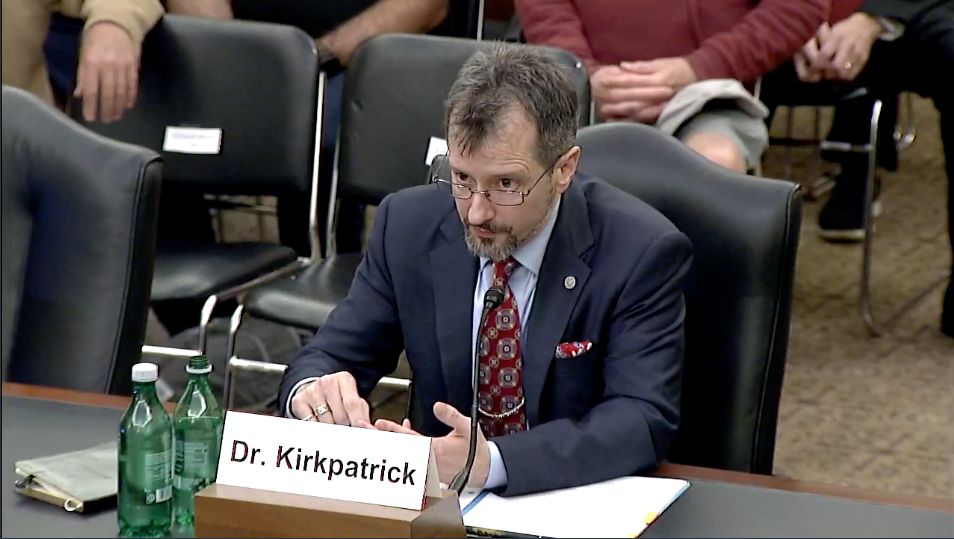Sean Kirkpatrick’s abrupt exit from the All-Domain Anomaly Resolution Office (AARO) after just 18 months has sent ripples through the UFO community. His tenure, marked by groundbreaking work and contentious statements, leaves a legacy of both admiration and skepticism. Kirkpatrick, a figure both celebrated for his expertise and critiqued for his forthrightness, has become a focal point in the ongoing debate about UFOs and extraterrestrial life. His departure not only raises questions about the future of UAP research but also reflects the complex dynamics within the UFO community. Kirkpatrick’s approach, often seen as a blend of scientific rigor and controversial skepticism, has stirred a mix of respect and discontent among UFO enthusiasts and researchers alike.

Early Life and Involvement with the UFO Community
Sean Kirkpatrick, born in 1967 or 1968 in Columbus, Georgia, embarked on his journey into the world of UFOs with a robust academic background. He completed his BS in 1991 and later earned a Ph.D. in physics from the University of Georgia in 1995. His doctoral research delved into the complex realm of nonlinear and nonequilibrium phonon dynamics in rare earth doped fluoride crystals. This strong foundation in physics laid the groundwork for his future involvement in the mysterious and often controversial field of unidentified aerial phenomena (UAPs).
Career Highlights and UFO Endeavors
Kirkpatrick’s illustrious career spanned over 27 years in federal service, involving significant roles at the Air Force Research Laboratory, the Central Intelligence Agency, and the Defense Intelligence Agency. Notably, he served as the chief scientist at the Defense Intelligence Agency’s Missile and Space Intelligence Center and as deputy director of intelligence for both U.S. Strategic Command and U.S. Space Command. His appointment as the first director of the All-Domain Anomaly Resolution Office (AARO) in July 2022 marked a pivotal moment in his career. At AARO, Kirkpatrick was instrumental in establishing formal processes and mechanisms for the Pentagon and intelligence community to address and make sense of UAPs. Under his leadership, the office investigated over 800 military-aligned UAP reports and included more than 40 DOD personnel.
Controversies and Clashes
During his tenure at AARO, Kirkpatrick faced numerous challenges, including public harassment, whistleblower complaints, and demands for transparency from Congress. Despite these controversies, he remained committed to his goals and focused on bringing a scientific and analytical approach to UAP investigations. His departure from AARO in December 2023 was not driven by these challenges but by his personal and professional objectives. Kirkpatrick’s approach often clashed with popular UFO theories, leading to heated exchanges with figures like Travis Taylor, a prominent name in UFO research. These confrontations underscored the tension between Kirkpatrick’s empirical methodology and the speculative theories that dominate much of the UFO discourse.
No holds barred!
— Dan Warren (@HeyLukOverThere) January 22, 2024
UFO heavyweights spar in a battle of wits!
Who's being an honest broker and who's shoveling manure!?!@Cedar_Anthony @DeclassifyUAP @MiddleOfMayhem @LueElizondo @MickWest @travisstaylor1 pic.twitter.com/uJR010ljXA
The Infamous Article and Its Fallout
On January 19, 2024, Sean Kirkpatrick’s op-ed in Scientific American marked a turning point in his relationship with the UFO community. His unequivocal statement that no evidence of extraterrestrial life was found during his tenure at AARO, coupled with a critique of the UFO narrative as a mix of misinformation and sensationalism, sparked widespread controversy. Many in the UFO community viewed his assertions as a betrayal, challenging long-held beliefs and theories. This article, alongside his previous confrontations cemented Kirkpatrick’s status as a polarizing figure in the field. His stance, perceived as dismissive of the UFO community’s efforts and beliefs, led to significant backlash and debate.
Here is the article that he wrote: “Here’s What I Learned as the U.S. Government’s UFO Hunter“
The Impact on the UFO Community
Kirkpatrick’s tenure at AARO and his public statements have significantly impacted the UFO community. His departure, following a period of intense scrutiny over more than 800 UFO sightings, has intensified the divide within the community. On one side are those advocating for scientific explanations for UAPs, and on the other, individuals inclined towards more extraordinary interpretations. Kirkpatrick’s confrontational approach, particularly his clashes with prominent UFO researchers like Travis Taylor, symbolizes this growing rift. His scientific rigor, often at odds with the speculative nature of UFO discourse, has been both a source of respect and contention.
Travis Taylor got into it with Sean Kirkpatrick over his Scientific American article.
— ᴋʟᴀᵾs (@tinyklaus) January 19, 2024
Credit to u/Dbz_god1 on Reddit.
Goddamn. 🫠https://t.co/adclGxj3dS pic.twitter.com/KuCglegHam
A Legacy of Division or Enlightenment?
Sean Kirkpatrick’s journey in the UFO landscape has been nothing short of complex and contentious. His steadfast commitment to scientific inquiry in a field often dominated by speculation and conspiracy theories has garnered both admiration and criticism. As he steps away from his role at AARO, the UFO community is left to ponder the questions he raised and the debates he sparked. While Kirkpatrick views his departure as a fulfillment of his personal and professional goals, many speculate that the ongoing clashes with fellow UFO enthusiasts and the divisive nature of his tenure played a significant role in this decision. Whether seen as a beacon of rationality or a divisive figure, Kirkpatrick’s influence on the discourse surrounding UFOs and extraterrestrial life remains a topic of intense debate. His legacy, marked by division and enlightenment, continues to shape the narrative and future of UFO research.
